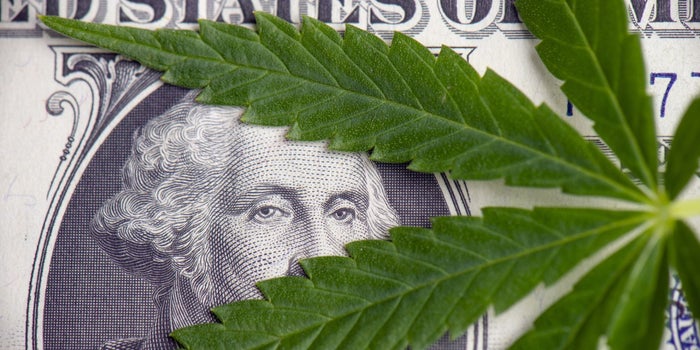5 Positive Trends For the Cannabis Industry

As a venture capital investor, I'll confess we’ve seen our fair share of unexpected triggers that cause a company to turn into a sales rocket ship. But the past few weeks have been unprecedented. In a bizarre turn of events across the country, as lockdowns and uncertainty spread alongside COVID-19, as businesses shuttered and stock markets panicked, one industry is booming—cannabis.
Sales have surged to new all-time highs, spiking nearly 160 percent in the weeks leading up to potential lockdowns and quarantines across legalized states. After months of what seemed to be perpetual negative news highlighting the marijuana public market plunge, could it be that cannabis is resurfacing while businesses around the U.S. are closing down?
Let’s break down the five trends we are seeing surrounding the plant, and why this industry may be uniquely positioned to succeed despite a general economic collapse.
1. Vices do well in a downturn
It doesn’t take a long walk through the past to see that vices and consumer staples, both of which arguably cannabis is, typically outperform or protect on the downside during a recession. There is a long history of alcohol as a parallel industry for cannabis and as having downside resistance during economic downturns. Whether it’s due to the need for entertainment, distraction, or anxiety release in humans under stress, historical trends seem to be on cannabis’s side.
2. Cannabis is a home-grown product
When news of the coronavirus hitting China began to surface, the early concern in the U.S. was not about our health, but the economic effect it would have on the supply chain of our largest industries, such as Apple, Microsoft, Walmart, and Big Pharma. Many companies and industries began to realize their reliance on Chinese manufacturing and raw materials as shocks to supply hit us and companies bottom lines. Not cannabis. Given the highly-regulated nature of cannabis and the fact you cannot import the product, the cannabis supply chain is largely domestic and has little to no exposure to China. That meant few, if any, shocks to its supply chain due to China’s shutdown.
3. Delivery services in high demand
Another trend paving the way for the industry is the move and allowance by state governments for curbside or delivery services to continue. With this trend, we have seen cannabis delivery services spike over 85 percent the past 30 days as states including MA, IL, MI, MD, and WA have taken steps to encourage delivery and/or curbside pickup. This may mean the salvation of companies with delivery as a core component of their business such as the cannabis delivery company, Eaze.
4. People consume at home
How and where the plant is consumed by consumers is also an advantage. Alcohol is often described as a social drug, whereas cannabis has historically been seen and utilized as a solitary drug—whether due to the stigma or its illegality. In fact, 59 percent of adult use Canadian consumers utilize cannabis at home and alone. The largest reasons for use are often listed as anxiety and sleep. This trend has certainly benefited the industry in a time of social distancing and shelter in place orders.
5. Cannabis is medicine
The single biggest driver of sales in this age of the coronavirus lockdown may be the simple fact that stores are allowed to stay open. In an unprecedented boon to the industry, and to users who rely on cannabis, the industry has been labeled an essential service in Nevada, California, and New York. California led the way by declaring that medical cannabis qualifies as essential, allowing certain businesses to stay open during the lockdown. Pause and consider the implications of that for a moment. The essential services list includes doctors, grocery stores, gas stations, and now cannabis. While we all fought hard to make this a reality, the fact that the government, while in a state of crisis, recognizes it is a profound indication of the change in climate towards the plant.
In that vein, while nothing can be a sure thing, the decision by these states to classify medical cannabis as essential, combined with these unprecedented times, may lead to a faster legalization process overall.
So the big question still remains: Is this a short-lived surge that will revert as the country either continues to lockdown or as consumers fill up their cannabis stockpiles? Or will the cannabis industry validate the historical counter-cyclical behavior we’ve come to anticipate from consumable ”vice” industries and even accelerate with these unique growth trends? Time will tell, but until then stockpiles continue to grow.
420 Intel is Your Source for Marijuana News
420 Intel Canada is your leading news source for the Canadian cannabis industry. Get the latest updates on Canadian cannabis stocks and developments on how Canada continues to be a major player in the worldwide recreational and medical cannabis industry.
420 Intel Canada is the Canadian Industry news outlet that will keep you updated on how these Canadian developments in recreational and medical marijuana will impact the country and the world. Our commitment is to bring you the most important cannabis news stories from across Canada every day of the week.
Marijuana industry news is a constant endeavor with new developments each day. For marijuana news across the True North, 420 Intel Canada promises to bring you quality, Canadian, cannabis industry news.
You can get 420 Intel news delivered directly to your inbox by signing up for our daily marijuana news, ensuring you’re always kept up to date on the ever-changing cannabis industry. To stay even better informed about marijuana legalization news follow us on Twitter, Facebook and LinkedIn.




